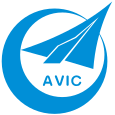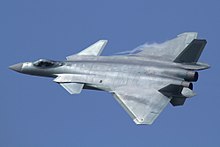Aviation Industry Corporation of China
 | |
 AVIC headquarters | |
Native name | 中国航空工业集团公司 |
|---|---|
| Type | State owned |
| Industry |
|
| Predecessor | China Aviation Industry Corporation I China Aviation Industry Corporation II |
| Founded | 1993 |
| Headquarters | Chaoyang District, Beijing , China |
Area served | Worldwide |
Key people | Tan Ruisong (Chairman and CEO)[1] |
| Products | Civil and military aircraft Unmanned aerial vehicles Trucks Automobile parts Electronics Robots Ships |
| Revenue | |
| Total assets | |
Number of employees | 446,613 (2015)[2][3] |
| Parent | SASAC |
| Divisions | |
| Subsidiaries |
|
| Website | www.avic.com/en |
| Aviation Industry Corporation of China | |||
|---|---|---|---|
| Simplified Chinese | 中国航空工业集团公司 | ||
| Traditional Chinese | 中國航空工業集團公司 | ||
| |||
| Abbreviation | |||
| Simplified Chinese | 中航工业 | ||
| Traditional Chinese | 中航工業 | ||
| |||
The Aviation Industry Corporation of China (AVIC) is a Chinese state-owned aerospace and defense conglomerate headquartered in Beijing. It is ranked 151st in the Fortune Global 500 list as of 2019,[2] and has over 100 subsidiaries, 27 listed companies and 500,000 employees across the globe.[4][5]
History[]
Since being established on 1 April 1951 during the Korean War as the Aviation Industry Administration Commission,[6] the aviation industry of the People's Republic of China has been through 12 systemic reforms.
AVIC purchased American aircraft engine manufacturer Continental Motors, Inc. in 2010, aircraft manufacturer Cirrus in 2011, and specialized parts supplier Align Aerospace in 2015.[7]
| Period | Organization name |
|---|---|
| Apr 1951 – Aug 1952 | Aviation Industry Bureau, Ministry of Heavy Industry |
| Aug 1952 – Feb 1958 | 4th Bureau, No.2 Mechanical Industry Department |
| Feb 1958 – Sept 1960 | 4th Bureau, No.1 Mechanical Industry Department |
| Sept 1960 – Sept 1963 | 4th Bureau, No.3 Mechanical Industry Department |
| Sept 1963 – Apr 1982 | No.3 Mechanical Industry Department |
| Apr 1982 – Apr 1988 | Ministry of Aviation Industry |
| Apr 1988 – Jun 1993 | Ministry of Aviation and Aerospace Industry |
| Jun 1993 – Jun 1999 | China Aviation Industry Corporation (中国航空工业总公司) |
| Jul 1999 – May 2008 | China Aviation Industry Corporation I (AVIC I), China Aviation Industry Corporation II (AVIC II) |
| May 2008 – Nov 2008 | China Aviation Industry Corporation I, China Aviation Industry Corporation II, Commercial Aircraft Corporation of China (COMAC) |
| Nov 2008 – Present | Aviation Industry Corporation of China, Commercial Aircraft Corporation of China[Note 1] |
Split and Re-merge[]
China Aviation Industry Corporation was split into two separate entities, China Aviation Industry Corporation I and China Aviation Industry Corporation II in 1999. Both retained civilian and military aircraft production capabilities, along with a number of unrelated business ventures. The split was intended to foster competitiveness in the Chinese aerospace industry.[8]
In 2008, AVIC I and AVIC II officially merged back together. The previous separation resulted in split resources and led to redundant projects. The goal of the merger was to eliminate this redundancy and spin off pursuits unrelated to aerospace, such as motorcycle and automobile parts manufacturing.[9]
Business segments[]
- Air transport manufacturing
- General aviation
- Helicopters
- Aircraft systems
- Automobiles
- Ships[10]
In 2015, AVIC teamed up with its partner, BHR Partners, in acquiring U.S. automotive supplier Henniges, through a joint venture structure.[11][12] Henniges called the deal "one of the largest acquisitions by a Chinese company of a U.S.-based automotive manufacturing company in history."[13]
Products[]



This list is incomplete; you can help by . (January 2021) |
Fighter aircraft[]
Fighter bomber aircraft[]
- JH-7
Trainer aircraft[]
Transport aircraft[]
Bomber aircraft[]
AEW&C aircraft[]
- KJ-200
- KJ-500
- KJ-2000
- Xian KJ-600
Helicopter[]
- AC313
- Z-8
- Z-9
- Z-11
- Z-15
- Z-18
- Z-20
- Z-10
- Z-19
- AVIC Advanced Heavy Lifter
- MD Helicopters MD 500
- MD600
- MD530F
- MD520N
- Harbin Z-5
- Harbin/CHDRI Z-6
- Harbin Z-9Harbin Z-9W/G
- Harbin Z-15/EC175
- HC-120/EC120
Unmanned aerial vehicle[]
- Pterodactyl I
- WZ-2000
- Soar Dragon
- AVIC 601-S
- AVIC Dark Sward
- AVIC Sharp Sword
- GAIC Harrier Hawk
- AVIC Cloud Shadow
- Chengdu Xianglong
- CAIG Sky Wing
Airliner[]
| List of airliners of AVIC | |||||||||||||||||||
|---|---|---|---|---|---|---|---|---|---|---|---|---|---|---|---|---|---|---|---|
| Aircraft | Type | Description | Developer | Seats | Number Built | Maiden Flight | Introduction | Production Ceased | Retired | ||||||||||
| Xian MA60 | Turboprop Airliner | Turboprop Regional airliner | Xi'an Aircraft Industrial Corporation | 62 | 25 February 2000 | ||||||||||||||
| Xian MA600 | Turboprop Airliner | Turboprop Regional airliner | Xi'an Aircraft Industrial Corporation | 60 | 10 October 2008 | ||||||||||||||
| Xian MA700 | Turboprop Airliner | Turboprop Regional airliner | Xi'an Aircraft Industrial Corporation | 68-86 | planned November 2019 | ||||||||||||||
| CBJ800 | Jet airliner | Business jet | Chengdu Aircraft Industry Group | 9-12 | planned 2016 | ||||||||||||||
| Comac ARJ21-700 | Jet airliner | Regional jet | Comac | 78-90 | 28 November 2008 | ||||||||||||||
| Comac C919 | Jet airliner | Twin-engine Narrow-body aircraft | Comac | 158-168 | |||||||||||||||
Electronic-warfare aircraft[]
- Y-8DZ
- Y-8CA
- Y-8GX1
- Y-8GX3
- Y-8GX4
- Y-8GX7
- Y-8Q
- Y-8 Anti-Submarine Aircraft
- Y-8EW
- ZDK-06
- Y-8CB
- Y-8JB
- Y-8XZ
- Shenyang J-16D
- Y-9G (GX-11)
- GX-8
Maritime-patrol aircraft[]
- Harbin SH-5
- Harbin PS-5
- AVIC AG600
- Y-8FQ
Controversy[]
In April 2009, The Wall Street Journal reported that computer spies, allegedly Chinese, "had penetrated the database of the Joint Strike Fighter program and acquired terabytes of secret information about the fighter, possibly compromising its future effectiveness."[14] AVIC allegedly "incorporated the stolen know-how into China's Chengdu J-20 and Shenyang FC-31 fighters."[15][16][17]
In November 2020, Donald Trump issued an executive order prohibiting any American company or individual from owning shares in companies that the United States Department of Defense has listed as having links to the People's Liberation Army, which included AVIC.[18][19][20][21]
See also[]
- List of aircraft produced by China
- Commercial Aircraft Corporation of China (COMAC)
- Aero Engine Corporation of China (AECC)
Notes[]
References[]
- ^ Aviation Industry Corporation of China. "Leadership - AVIC". Archived from the original on 2019-11-09. Retrieved 2018-05-31.
- ^ Jump up to: a b c d e "151: Aviation Industry Corporation of China". Fortune Global 500.
- ^ "Overview". AVIC. Archived from the original on 2016-03-05. Retrieved 2015-11-11.
- ^ "AVIC overview".
- ^ "China's NORINCO, AVIC Among Top 10 Defense Companies Worldwide; SIPRI". www.defenseworld.net.
- ^ "China's Boeing Wannabe Could Land in U.S. Government Crosshairs". Bloomberg News. October 12, 2020. Retrieved October 18, 2020.
- ^ "AVIC International buys PE-backed Align" (Press release). PE Hub Network. March 31, 2015. Retrieved June 2, 2018.
- ^ Nolan, Peter (2001). China and the Global Economy: National Champions, Industrial Policy, and the Big Business Revolution. New York: Palgrave. p. 30. ISBN 0333945654.
- ^ Lu, Haoting; Xu, Dashan (18 June 2008). "AVIC I & II closer to merger". China Daily. Archived from the original on 27 February 2020. Retrieved 24 March 2020.
- ^ "AVIC Ship Shareholder Structure". Archived from the original on 2016-04-07. Retrieved 2019-07-06.
- ^ "BHR and AVIC Auto Acquire Henniges Automotive". PR Newswire. September 15, 2019.
- ^ "Henniges is acquired by China's AVIC Auto". Sealing Technology. 2015 (11): 4–5. 2015-11-01. doi:10.1016/S1350-4789(15)30341-X. ISSN 1350-4789.
- ^ "Henniges Automotive acquired by China's AVIC Automotive". Automotive News. September 11, 2015.
- ^ Gorman S, Cole A, Dreazen Y (April 21, 2009). "Computer Spies Breach Fighter-Jet Project Article". The Wall Street Journal.CS1 maint: multiple names: authors list (link)
- ^ "Stolen F-35 secrets now showing up in China's stealth fighter". Fox News. 20 December 2015.
- ^ "New Snowden Documents Reveal Chinese Behind F-35 Hack". The Diplomat. 27 January 2015.
- ^ "America says China's fifth-generation jet fighter J-31 stolen from its F-35". The Economic Times. 13 November 2015.
- ^ "Factbox: List of 31 Chinese companies designated by the U.S. as military-backed". Reuters. 2020-11-13. Archived from the original on November 13, 2020. Retrieved 2020-11-18.
- ^ Chen, Shawna (November 12, 2020). "Trump bans Americans from investing in 31 companies with links to Chinese military". Axios. Retrieved November 12, 2020.
- ^ Pamuk, Humeyra; Alper, Alexandra; Ali, Idrees (2020-11-12). "Trump bans U.S. investments in firms linked to Chinese military". Reuters. Retrieved 2020-11-12.
- ^ Swanson, Ana (2020-11-12). "Trump Bars Investment in Chinese Firms With Military Ties". The New York Times. ISSN 0362-4331. Retrieved 2020-11-13.
External links[]
| Wikimedia Commons has media related to Aviation Industry Corporation of China. |
- Government-owned companies of China
- Aerospace companies of China
- Aircraft manufacturers of China
- Defence companies of the People's Republic of China
- Manufacturing companies based in Beijing
- Chinese companies established in 1993
- Technology companies established in 1993
- Manufacturing companies established in 1993
- Chinese brands